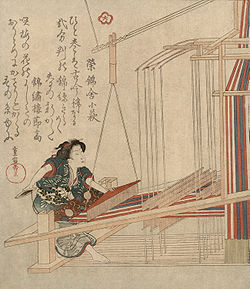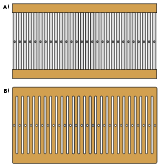
Heddle
Encyclopedia



Loom
A loom is a device used to weave cloth. The basic purpose of any loom is to hold the warp threads under tension to facilitate the interweaving of the weft threads...
. Each thread in the warp
Warp (weaving)
In weaving cloth, the warp is the set of lengthwise yarns that are held in tension on a frame or loom. The yarn that is inserted over-and-under the warp threads is called the weft, woof, or filler. Each individual warp thread in a fabric is called a warp end or end. Warp means "that which is thrown...
passes through a heddle, which is used to separate the warp threads for the passage of the weft
Weft
In weaving, weft or woof is the yarn which is drawn through the warp yarns to create cloth. In North America, it is sometimes referred to as the "fill" or the "filling yarn"....
. The typical heddle is made of cord or wire, and is suspended on a shaft of a loom
Loom
A loom is a device used to weave cloth. The basic purpose of any loom is to hold the warp threads under tension to facilitate the interweaving of the weft threads...
. Each heddle has an eye in the center where the warp is threaded through. As there is one heddle for each thread of the warp, there can be near a thousand heddles used for fine or wide warps. A handwoven tea-towel will generally have between 300 and 400 warp threads , and thus use that many heddles.
In weaving, the warp threads are moved up or down by the shaft. This is achieved because each thread of the warp goes through a heddle on a shaft. When the shaft is raised the heddles are too, and thus the warp threads threaded through the heddles are raised. Heddles can be either equally or unequally distributed on the shafts, depending on the pattern to be woven. In a plain weave
Plain weave
Plain weave is the most basic of three fundamental types of textile weaves . It is strong and hard-wearing, used for fashion and furnishing fabrics....
or twill
Twill
Twill is a type of textile weave with a pattern of diagonal parallel ribs . This is done by passing the weft thread over one or more warp threads and then under two or more warp threads and so on, with a "step" or offset between rows to create the characteristic diagonal pattern. Because of this...
, for example, the heddles are equally distributed.
The warp is threaded through heddles on different shafts in order to obtain different weave structures. For a plain weave on a loom with two shafts, for example, the first thread would go through the first heddle on the first shaft, and then the next thread through the first heddle on the second shaft. The third warp thread would be threaded through the second heddle on the first shaft, and so on. In this manner the heddles allow for the grouping of the warp threads into two groups, one group that is threaded through heddles on the first shaft, and the other on the second shaft.
While the majority of heddles are as described, this style of heddle has derived from older styles, several of which are still in use. Rigid heddle looms, for example, instead of having one heddle for each thread, have a shaft with the 'heddles' fixed, and all threads go through every shaft.
Wire heddles


There are three different common types of metal heddles: wire, inserted eye, and flat steel. The inserted eye are considered to be the best, as they have a smooth eye with no rough ends to catch the warp. Wire heddles are second in quality, followed by the flat steel. Wire heddles look much like the inserted eye heddles, but where in the inserted eye there is a circle of metal for the eye, the wire ones are simply twisted at the top and bottom. The flat metal heddles are considered the poorest in quality as they are heavier and bulkier, as well as not being as smooth. They are a flat piece of steel, with the ends rotated slightly so that the flat side is at an angle of 45 degrees to the shaft. The eye is simply a hole cut in the middle of the piece of metal.
String heddles

Historical reenactment
Historical reenactment is an educational activity in which participants attempt torecreate some aspects of a historical event or period. This may be as narrow as a specific moment from a battle, such as the reenactment of Pickett's Charge at the Great Reunion of 1913, or as broad as an entire...
. They are also used to lessen the weight of the shafts.
A very simple string heddle can be made with a series of five knots, and five loops. Of these loops, the important ones are the two on the ends and in the center. The loops on the ends are where the shaft goes through the heddle, and the center loop is the eye. The knots are placed around these key features- the eye is made to be in the center, and the end loops are just big enough for the heddle to slide along the shaft. String heddles can also be crochet
Crochet
Crochet is a process of creating fabric from yarn, thread, or other material strands using a crochet hook. The word is derived from the French word "crochet", meaning hook. Hooks can be made of materials such as metals, woods or plastic and are commercially manufactured as well as produced by...
ed, and come in many different forms.
Inkle looms
The heddles on an inkle loom, while they are of a completely different form, are generally made of string. Inkle looms only require a simple loop for a heddle, and every other thread goes through a heddle, as in a rigid heddle loom.Tapestry loom
Tapestry loom heddles have yet another form, and are generally made of string as well. The heddles here are a loop of string with an eye at one end for the warp, and a loop at the other for a heddle bar.Repair heddles

Rigid heddles

Rigid heddles are thus very different from the heddle in common use, though the single heddle derived from the rigid heddle. The advantage of non-rigid heddles is that the weaver has more freedom, and can create a wider variety of fabrics. Rigid heddle looms resemble the standard floor loom in appearance.
Single and double heddle looms
Single and double heddle looms are a type of rigid heddle loom, in that the heddles are all together. Heddles are normally suspended above the loom. The weaver operates them by pedals and works while seated.Among hand woven African textiles
African textiles
The earliest surviving sub-Saharan African textiles are cloth fragments and parchment fragments that date to the ninth century BC from sites at Igbo Ukwu of the Igbo people of Nigeria. Some twelfth century cloth fragments date from the Tellem caves in Mali...
, single-heddle looms are in wide use among weaving regions of Africa. Mounting position varies according to local custom. Double-heddle looms are used in West Africa, Ethiopia
Ethiopia
Ethiopia , officially known as the Federal Democratic Republic of Ethiopia, is a country located in the Horn of Africa. It is the second-most populous nation in Africa, with over 82 million inhabitants, and the tenth-largest by area, occupying 1,100,000 km2...
and in Madagascar
Madagascar
The Republic of Madagascar is an island country located in the Indian Ocean off the southeastern coast of Africa...
for the production of lamba
Lamba (garment)
A lamba is the traditional garment worn by both men and women in Madagascar. This textile, highly emblematic of Malagasy culture, consists of a rectangular length of cloth wrapped around the body....
cloth. .

